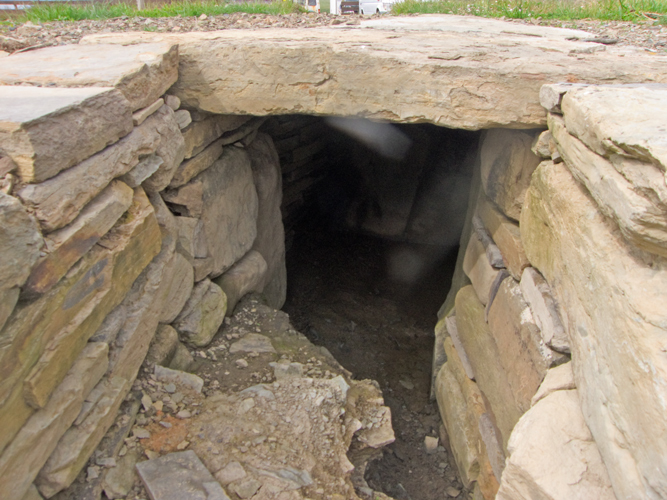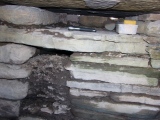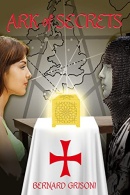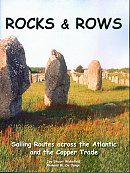<< Our Photo Pages >> Banks Chambered Tomb - Chambered Cairn in Scotland in Orkney
Submitted by coldrum on Monday, 30 April 2012 Page Views: 31075
Neolithic and Bronze AgeSite Name: Banks Chambered Tomb Alternative Name: Tomb of the OttersCountry: Scotland County: Orkney Type: Chambered Cairn
Nearest Village: Burwick
Map Ref: ND45808339
Latitude: 58.734772N Longitude: 2.937914W
Condition:
| 5 | Perfect |
| 4 | Almost Perfect |
| 3 | Reasonable but with some damage |
| 2 | Ruined but still recognisable as an ancient site |
| 1 | Pretty much destroyed, possibly visible as crop marks |
| 0 | No data. |
| -1 | Completely destroyed |
| 5 | Superb |
| 4 | Good |
| 3 | Ordinary |
| 2 | Not Good |
| 1 | Awful |
| 0 | No data. |
| 5 | Can be driven to, probably with disabled access |
| 4 | Short walk on a footpath |
| 3 | Requiring a bit more of a walk |
| 2 | A long walk |
| 1 | In the middle of nowhere, a nightmare to find |
| 0 | No data. |
| 5 | co-ordinates taken by GPS or official recorded co-ordinates |
| 4 | co-ordinates scaled from a detailed map |
| 3 | co-ordinates scaled from a bad map |
| 2 | co-ordinates of the nearest village |
| 1 | co-ordinates of the nearest town |
| 0 | no data |
Internal Links:
External Links:
I have visited· I would like to visit
coin whese001 drolaf would like to visit
bettynesbitt visited on 3rd Jul 2012 - their rating: Cond: 4 Amb: 5 Access: 5 An amazing site easy access. Well set up by Mr Mowatt. Just around the corner to the Tomb of the Eagles. Members of Bidston Community Archaeology had a fieldtrip to Orkney with the intention of seeing Tomb of the Eagles and we passed the sign (can't miss it) to Banks Chambered Tomb not realising this Tombs importance I returned the next week and was stunned by its significance.
paulinelen visited on 5th Apr 2012 - their rating: Cond: 4 Amb: 5 Access: 5 a work in progress and rather wet underfoot but amazing - still doing the £5 guided tour and its a site not to be missed - food was good in the bistro too
Andy B Redfun have visited here
Average ratings for this site from all visit loggers: Condition: 4 Ambience: 5 Access: 5

See the comments below for updates. Hamish Mowatt dug a hole close to an 8ft-long stone in the garden, next to the Skerries Bistro, which is run by his fiancee Carole Fletcher, and discovered a chamber inside with about 9in of water lying on the bottom.
He managed to get an underwater camera into the hole and saw what appeared to be the two eyesockets of a skull. The couple contacted Julie Gibson, an archaeologist with Orkney Islands Council, who said the site was a Stone Age chambered tomb.
A rescue excavation was undertaken by the Orkney Research Centre for Archaeology, sponsored by Orkney Islands Council and Historic Scotland.
It is thought that the structure might contain three chambers, one of which has been cut down into rock and is capped by a massive flat stone. At least three skulls have been seen, and possibly pottery, which need to be recovered before the water inside the structure destroys them. Archaeologists say it is an exciting find in itself and also because it is near the Isbister Chambered Cairn, or Tomb of the Eagles, on the south-eastern tip of South Ronaldsay.
This cairn contains a cache of tools, including axe heads and a knife, as well as human remains in a chamber.
Ms Gibson said: "Not only do we have the discovery of relatively undisturbed human remains, but we've now got two tombs - the Banks tomb and the nearby Tomb of the Eagles - in close proximity and both found in relatively recent times, where we can see how the dead were being handled in the Neolithic."
Dan Lee, a project officer with the Orkney Research Centre for Archaeology, said: "We are trying to recover as much information as possible from the tomb. We can see gaps between the top slab and the voids inside, so it's a really exciting prospect for us.
"We will excavate the central passageway and look inside the cells to see the preservation and condition of the human remains. We may encounter single burials or a whole jumble of bones as over 5,000 years ago they used to bury the dead communally. So we don't know what we might find in there, but it should be very interesting."
Isbister Chambered Cairn is estimated to have been built around 3,000 BC, and used for approximately 800 years.
It is just over 11ft high and consists of a rectangular main chamber, divided into stalls and side cells.
Talons from the white-tailed sea eagle and the remains of up to 20 birds were found inside the tomb - the inspiration for it's popular name. Found alongside human remains, it is believed the birds, once common in Orkney, were perhaps a totem of the people who built the tomb.
In all, 16,000 human bones were found at the site, as well as 725 from birds, mainly sea eagles. Recent dating techniques suggest the birds died around 2450-2050 BC, up to 1,000 years after the building of the tomb.
This would confirm growing evidence that the Neolithic tombs of Orkney remained in use for many generations.
Source: The Scotsman (Archive Link)
Official Web Site: www.bankschamberedtomb.co.uk
Current Opening: April to September
11:00 - 17:00 (last tour 16:00)
Admission Charge
Please call 01856 831605 if you would like any further information.
Note: Dig discovers a possible sixth chamber in Banks chambered tomb
You may be viewing yesterday's version of this page. To see the most up to date information please register for a free account.
























These are just the first 25 photos of Banks Chambered Tomb. If you log in with a free user account you will be able to see our entire collection.
Do not use the above information on other web sites or publications without permission of the contributor.
Click here to see more info for this site
Nearby sites
Key: Red: member's photo, Blue: 3rd party photo, Yellow: other image, Green: no photo - please go there and take one, Grey: site destroyed
Download sites to:
KML (Google Earth)
GPX (GPS waypoints)
CSV (Garmin/Navman)
CSV (Excel)
To unlock full downloads you need to sign up as a Contributory Member. Otherwise downloads are limited to 50 sites.
Turn off the page maps and other distractions
Nearby sites listing. In the following links * = Image available
574m NE 43° Tomb of the Eagles Museum Museum (ND4619783807)
975m NE 42° Isbister: Bronze Age House* Ancient Village or Settlement (ND46468411)
1.0km NE 41° Liddel 2 Burnt Mound Ancient Village or Settlement (ND46498416)
1.4km NE 52° Duni Geo* Long Barrow (ND46958425)
1.7km NE 48° Isbister: Tomb Of The Eagles* Chambered Cairn (ND47048449)
2.0km WNW 296° Ladykirk Stone* Rock Art (ND44008428)
3.9km N 359° The Cairns Windwick Bay* Broch or Nuraghe (ND4578987256)
5.6km N 6° Stews* Standing Stone (Menhir) (ND465890)
6.0km NNW 336° Weems Castle Broch or Nuraghe (ND434889)
6.6km NNW 339° Clouduhall Stone* Standing Stone (Menhir) (ND43538957)
6.6km NNW 339° Clouduhall Cairn* Round Cairn (ND43498958)
7.6km N 8° Kirkhouse* Round Cairn (ND470909)
7.9km N 11° Kirk Ness* Round Cairn (ND47389117)
8.0km N 11° Kirk Ness Dyke* Ancient Village or Settlement (ND474912)
8.1km N 7° Eastside* Standing Stone (Menhir) (ND469914)
8.2km NNW 328° Harra Brough* Broch or Nuraghe (ND41579038)
9.4km NNW 346° Oyce of Quindry* Standing Stone (Menhir) (ND436925)
10.4km NNW 345° The Wart* Chambered Cairn (ND433935)
11.1km NNW 342° Howe of Hoxa* Broch or Nuraghe (ND425940)
11.1km NNW 342° Little Howe of Hoxa* Ancient Village or Settlement (ND4243694026)
11.1km NNW 342° Little Howe of Hoxa* Ancient Village or Settlement (ND42439403)
12.2km NNE 12° Kyelittle* Broch or Nuraghe (ND485953)
12.8km WNW 296° Cantick Head Bowl Barrow Round Barrow(s) (ND34318915)
13.1km WNW 297° Outer Green Hill Broch Chambered Cairn (ND34258958)
13.3km WNW 294° Green Hill of Hestigeo Broch or Nuraghe (ND33758905)
View more nearby sites and additional images






 We would like to know more about this location. Please feel free to add a brief description and any relevant information in your own language.
We would like to know more about this location. Please feel free to add a brief description and any relevant information in your own language. Wir möchten mehr über diese Stätte erfahren. Bitte zögern Sie nicht, eine kurze Beschreibung und relevante Informationen in Deutsch hinzuzufügen.
Wir möchten mehr über diese Stätte erfahren. Bitte zögern Sie nicht, eine kurze Beschreibung und relevante Informationen in Deutsch hinzuzufügen. Nous aimerions en savoir encore un peu sur les lieux. S'il vous plaît n'hesitez pas à ajouter une courte description et tous les renseignements pertinents dans votre propre langue.
Nous aimerions en savoir encore un peu sur les lieux. S'il vous plaît n'hesitez pas à ajouter une courte description et tous les renseignements pertinents dans votre propre langue. Quisieramos informarnos un poco más de las lugares. No dude en añadir una breve descripción y otros datos relevantes en su propio idioma.
Quisieramos informarnos un poco más de las lugares. No dude en añadir una breve descripción y otros datos relevantes en su propio idioma.